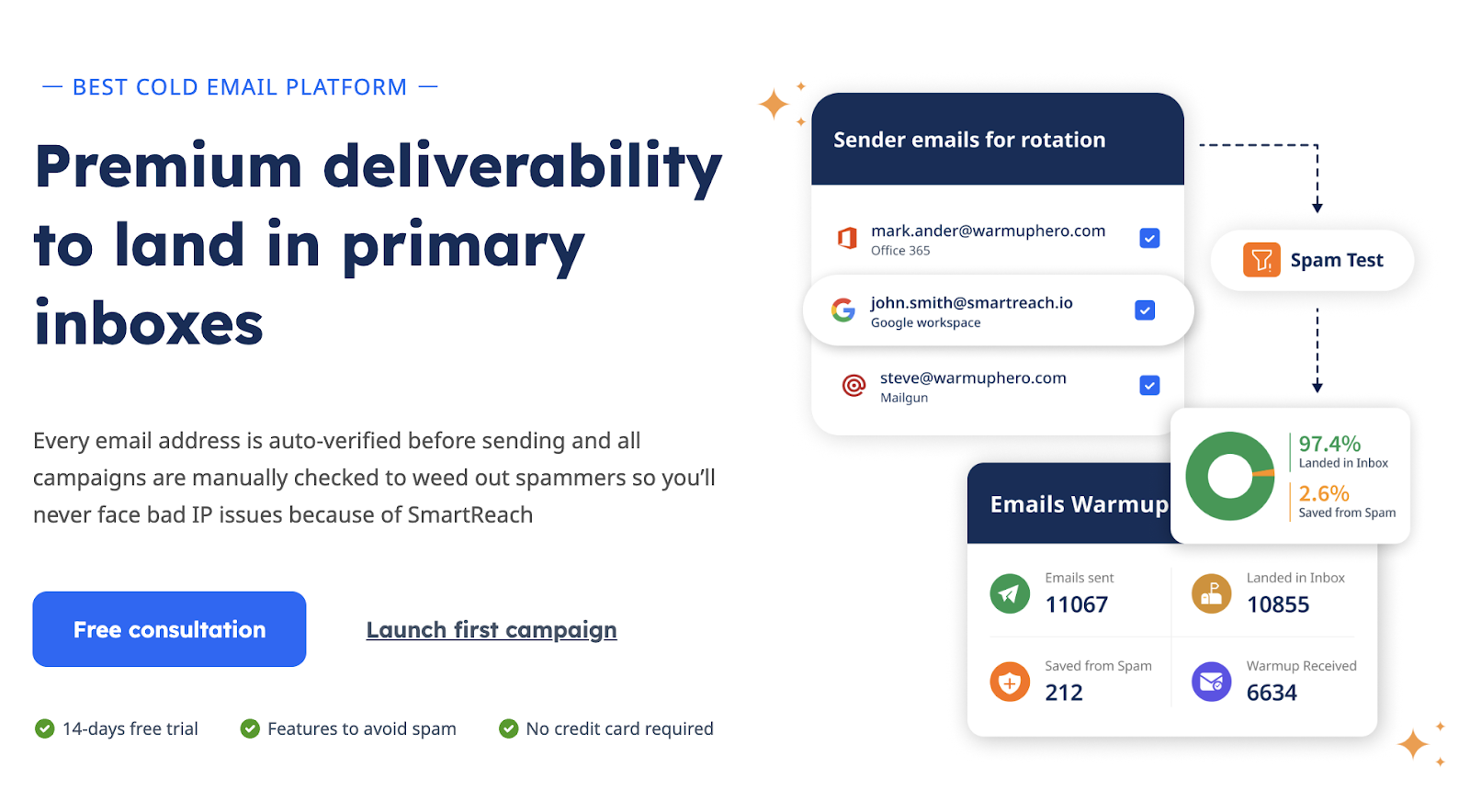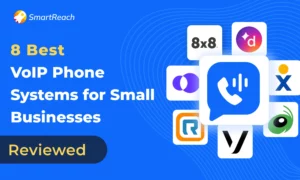How to Prevent Recipients from Marking Emails as Spam?
When recipients mark your emails as spam, it damages your sender reputation, reduces open rates, and disrupts your entire email marketing workflow.
This guide outlines everything you can do to prevent email recipients marking your emails spam.
These tips will help cold emailers, email marketers and newsletter creators equally.
TL;DR – How to prevent emails from going to spam
- Build your email list using clear opt-ins; avoid buying lists from unknown sources.
- Use double opt-in to verify email addresses and remove fake or mistyped entries.
- Clearly explain what kind of emails subscribers will get and how often.
- Make unsubscribing easy to avoid recipients hitting the spam button.
- Segment your list by source, activity, or user traits for better targeting.
- Clean your email list regularly
- Use professional and branded email addresses for email outreach
- Authenticate your domain with SPF, DKIM, and DMARC for better deliverability.
- Personalize your emails build trust with the email recipients
- Send emails during weekday work hours, ideally between 10 AM to 12 PM.
- Avoid BCCs, no-reply addresses, or vague intros like “Dear user.”.
- Ask recipients to whitelist your email and click “Not Spam” if needed.
The list doesn’t end here. There are more way to do it. I have discussed it below for each point.
How are emails marked as SPAM?
There are 2 ways emails are marked as spam –
- By email spam filters: Spam filters inside email services analyze a wide range of factors before deciding where your email should land inbox, promotions, or spam.
- Manual spam by recipients: Email recipients also manually mark emails as spam based on a number of factors such as misleading email subject line, poor email list quality etc.
How to prevent email recipients from marking emails as SPAM?
Here are some strategies and tips to avoid your emails from getting marked as spam.
1. Develop a quality email list
A clean and engaged email list is foundational to avoid manual spamming by the recipients.
Key practices:
- Use clear opt-in forms on your website, blog, or landing pages to collect emails.
- Skip purchasing email lists from unknown sites. They usually contain outdated, fake, or uninterested leads and causes bounces and spam complaints.
- Use double opt-in confirmation to validate email addresses. Once someone signs up, send a follow-up email asking them to confirm. This filters out:
- Fake or mistyped emails
- Spam traps and bots
- Unengaged leads who won’t open or click anyway
Pro Tip: You can try SmartReach.io, a cold email platform that provides in-built unlimited email data validation. It validates the email list automatically before sending emails.
Read more: 7 Ways to build and grow a business email list from scratch
2. Set expectations and keep your list healthy
Once someone agrees to be a part of your email list, how you treat them matters just as much as how they got there.
Key practices:
A) Clearly communicate what content they’ll receive, including:
- The frequency of emails (e.g., weekly updates, monthly newsletters)
- Type of content (deals, guides, product news, tips, etc.)
- The sender (personalized or branded email address)
B) Make unsubscribing easy. Don’t hide the opt-out link or use dark UX. If users can’t leave easily, they’ll hit “Spam.”
C) Segment your email list early based on:
- Source of signup (webinar, pricing page, referral, etc.)
- Engagement (open/click/response activity)
- Location or company size
D) Perform regular list cleaning, like –
- Remove email contacts who haven’t opened in 60–90 days
- Send 1 re-engagement campaigns before removal
E) Avoid over-emailing. Follow a consistent, respectful cadence don’t suddenly shift to daily promos if they signed up for monthly tips.
3. Use professional email domains (avoid free ones)
If you’re using the free Gmail, Yahoo, or Outlook email addresses for sending cold emails, it’s a red flag for spam filters.
Also, the business decision-makers are more likely to hit your emails into spam due to lack of branding and authenticity.
❌ Why free email services don’t work cold emails –
- Free email services often have strict anti-spam policies for mass sending.
- Domains with @gmail.com are not meant for marketing or cold outreach.
- Authentication (SPF, DKIM, DMARC) can’t be properly configured on free domains.
✅ What to do instead:
- Buy custom domains, e.g., [email protected]. It boosts credibility.
- Set up dedicated cold email domains and inboxes if you’re doing outreach. This protects your main brand domain’s reputation.
- Authenticate your domain with SPF, DKIM, and DMARC. These are signals to inbox providers that your emails are legit.
Tip: Instead of manually setting up each email domain, buy pre-authenticated email domains and inboxes that are ready to send.
They won’t cost you anything more than $5 per month and you can buy them for monthly billing.
4. Write engaging and relevant emails to the recipients
Delivering value-packed, relevant email content help your emails from manual, spamming or getting flagged by the spam filters.
Key practices:
A) Personalize emails each recipient
- Emails should contain recipient name, company, location, job title, or previous interactions.
- Personalization increases trust and makes emails feel human rather than automated.
Action tip: Use an AI email writer that writes personalized emails based on your email list tags at scale.
B) Avoid spam-trigger words in emails
Words like “free”, “buy now”, “guaranteed”, or urgent can trigger spam filters, especially in subject lines or inside the email body.
Avoid them altogether in the emails to stay out of spam.
🎁 Free resource: 100+ Common Spam-trigger words in emails
C) Write clear & honest email subject lines
Your subject line must accurately reflect what’s inside the email. Misleading lines increase spam complaints by the recipients and erode trust.
For example, don’t say “Invoice Attached” if the email is a sales pitch.

Similarly, avoid email subject lines using “Re:” or “Fwd:” without context, as recipients mark them as spam more often, even when technically not spam.
5. Send at natural, human-friendly times
Sending emails late at night or during weekends often increases the chance of recipients flagging them as intrusive.
Choose delivery windows when people are actively checking work emails typically between 10 AM to 12 PM on weekdays (especially Tuesday to Thursday).
💡Pro tip: If sending cold emails across multiple time zones, use time zone-based scheduling to ensure relevance in every region.
6. Avoid common red flags in your email structure
A recipient can spot an impersonal or mass email from a mile away. Some tell-tale signs that lead to manual flagging include:
- BCCing multiple people (even subtly)
- Using no-reply email addresses
- Overly generic intros like “Dear User” or “To whom it may concern”
7. Provide value in the emails (not just a Pitch)
Recipients often report emails that look like cold sales spam.
One way to avoid this is by offering immediate value even in your first outreach.
For example:
- Share a quick insight related to their business
- Reference a blog post or article they’ve published
- Suggest a relevant free resource (not gated)
This creates a positive first impression, making the recipient less likely to mark your future email as spam.
8. Use real, reply-enabled email addresses
Never send emails from a “no-reply” address or a weird email alias.
Recipients are more likely to trust and engage with emails that look like they came from a real person.
✅ Better: [email protected]
❌ Worse: [email protected]
Also, set a friendly display name like “Jane from BrandName” or “BrandName Outreach.”
9. Get recipients to show positive engagement
- Ask them to add you: In welcome or first-touch emails, simply ask them to move your email to the inbox.
- Prompt replies and clicks: Write emails that invite short replies or include helpful links. This signals trust to spam filters.
- Add a quick note for spam folder rescue: Something like “Found this in spam? Click ‘Not Spam’ so it lands right next time.”
- Use trusted sender emails: Stick to older domains and email IDs with a history, they’re less likely to get flagged.
Conclusion
To avoid the spam folder build trust, consistency, and follow good email sending practices.
For cold emailers, using a reliable a cold email platform also matters in this case for consistent email deliverability and avoiding spam filters.
SmartReach.io is one of the leading AI-enabled cold email automation platform that runs email outreach campaigns on autopilot.

With its dedicated email deliverability suite, your cold emails land in the primary inbox of the prospects helping you book more sales demos.
Try it for FREE today. (No credit card required for the sign-up)
FAQs on preventing emails from being marked as spam
Q: Why do my emails go to spam despite opt-ins?
Even if users opted in, poor technical configuration, spammy words, or lack of engagement can still cause filtering.
Q: How can I get recipients to whitelist my emails?
Ask them to add your email address to their contacts list during onboarding or in your welcome email.
Q: Is using “free” in emails always a spam trigger?
Not always. When used sparingly and in the right context, it’s fine. Avoid using it excessively or in misleading subject lines.
Q: Should I avoid purchased email lists entirely?
Yes. They usually include low-quality leads or spam traps and can ruin your domain’s reputation.
Q: How do I check if my emails might go to spam?
Use spam-check tools like Mail-Tester, Mailtrap, or GlockApps to analyze your email before sending it.
Q: What’s the impact of spam traps on my emails?
Spam traps are planted to catch bad senders. If you hit them, ISPs may block your domain or lower your sender score.



